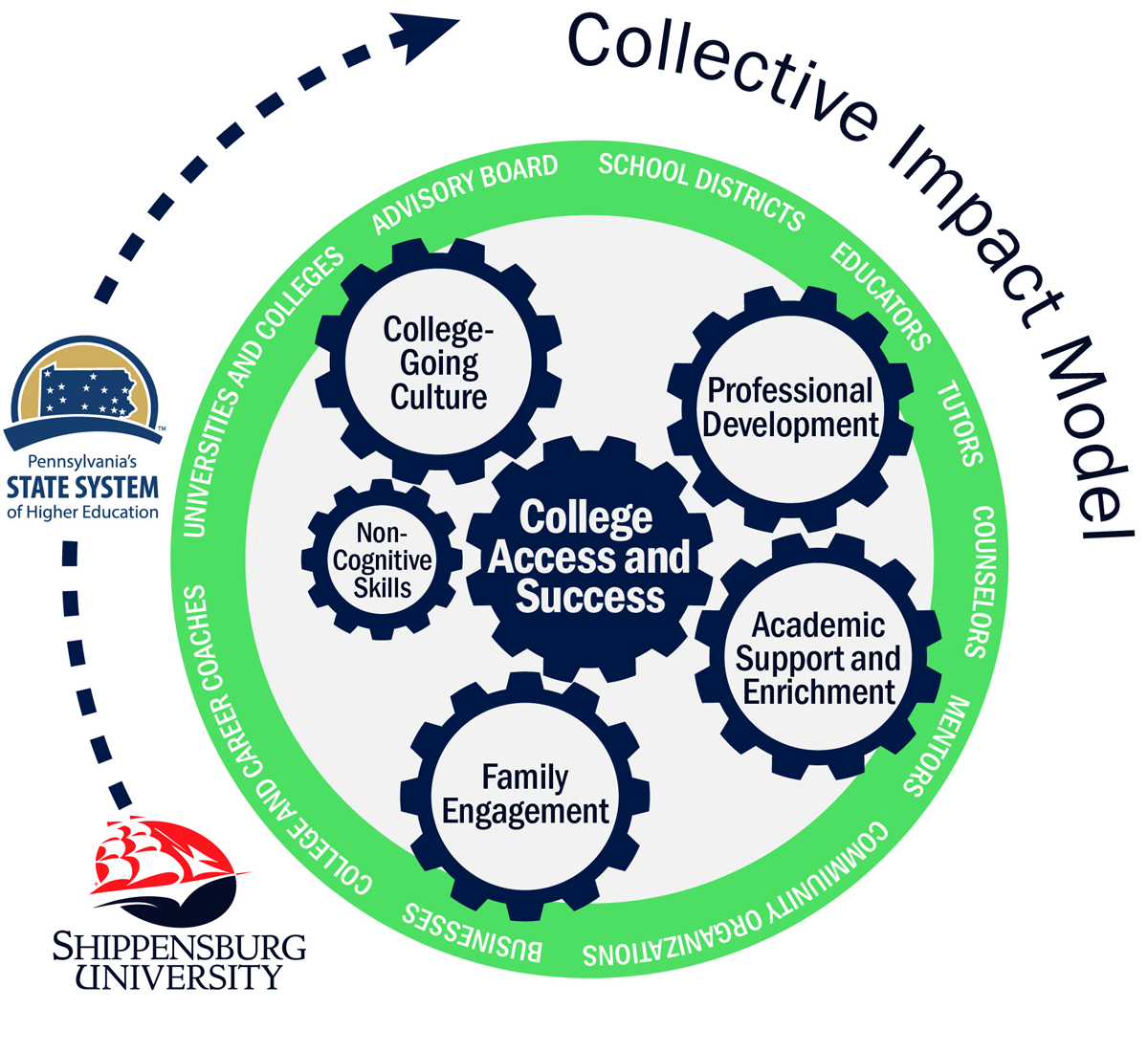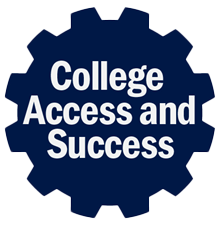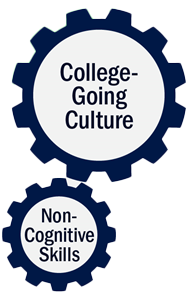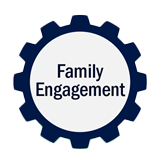PA State GEAR UP Design
PA State GEAR UP: Reach for the Future has identified four key components to achieve the vision of equitable College Access and Success for students which aims to increase enrollment and first-year to second-year persistence in postsecondary education.
Academic Support and Enrichment for students
Development a College-Going Culture
Family Engagement
Professional Development for educators
Collective Impact Model

To address the college access needs of its students and families, PA State GEAR UP uses a research-based Collective Impact Model.
Not just a collaborative, Collective Impact is a rigorous problem-solving process that brings together leaders from key organizations as well as representatives affected by the program (students, parents, educators). Focused on continuous learning, Collective Impact enables leaders from different community sectors to solve a specific problem. Collective Impact provides opportunities for reflection, dialogue, asking questions, challenging assumptions, and seeking feedback. This continuous feedback will inform PA State GEAR UP decisions, find synergies among grant partners, and seek results for GEAR UP students and families.
Each Collective Impact partner, listed on the outside of the circle, will use its expertise and resources toward one or more of these critical components.
Objectives and Performance Measures
All objectives and performance measures are designed to achieve the goal of: Equitable college access and success for students by increasing student achievement through data driven decisions, developing a sustainable college-going culture, and establishing a shared community vision for equitable college access and success.
| Objective |
Performance |
Services Provided to: |
Collective Impact Model |
|
1. Increase student achievement and preparation for postsecondary education by:
- Implementing evidence-based instructional strategies;
- Using data to identify gaps in instruction;
- Increasing the number of students who take rigorous courses; and
- Providing academic support to students.
|
85% of the GEAR UP cohort will pass Pre-Algebra by the end of 8th grade. 80% of the GEAR UP cohort will pass Algebra 1 by the end of 9th grade. (GPRA 1) 80% of the GEAR UP cohort will take two years of mathematics beyond Algebra 1 by 12th grade. Average daily attendance will increase by 3 percentage points in each district compared to the previous year’s non-GEAR UP students. 94% of GEAR UP students are promoted to the next grade level. Increase by 3 percentage points the percent of students scoring proficient or higher on state assessments (PSSAs) in 7th and 8th grades and successfully completing grade level courses or higher in 9th through 12th grades compared to previous year’s students. GEAR UP students will demonstrate an increase in their STEM identity. 80% of teachers participating in GEAR UP professional development will increase their perceptions of their abilities and confidence in delivery of instruction.
|
Teachers and School Personnel
Students
|


|
|
2. Develop a college-going culture by increasing the cohort graduation rate and preparation for postsecondary education by helping students:
- Explore careers and their requirements;
- Understand college entrance requirements including taking rigorous courses;
- Comprehend financial literacy as well as financial aid options;
- Identify the best college fit for themselves; and
- Increase academic mindset, perseverance, resiliency, and social-emotional skills.
|
90% of students in 11th grade who complete surveys are aware of the necessary academic preparation for college, financial aid options, and factors for a good college fit. 80% of the GEAR UP students will be on track to apply for college as measured by completion of the SAT or ACT by the end of the 11th grade. 90% of the GEAR UP cohort will graduate high school. (GPRA 2) GEAR UP students will demonstrate an increase in their non-cognitive skills
|
Students
|

|
|
3. Increase parent awareness of postsecondary education options, preparation, and financing by creating awareness about:
- The need for students to take rigorous secondary courses;
- College entrance requirements;
- Financial aid options as well as financial literacy; and
- How to help identify the best college fit for their child.
|
70% of parents actively engage in preparing students for postsecondary education as evidenced by participating in GEAR UP services. 70% of parents of 11th grade GEAR UP students who complete surveys are aware of postsecondary options, preparation, financing, and factors to determined best college fit. 70% of families complete the FAFSA. (GPRA 3)
|
Parents and Families
|

|
|
4. Increase enrollment and first-year to second-year persistence in postsecondary education institutions by:
- Implementing student leadership opportunities;
- Informing students about college life; and
- Providing information about supports and resources available in college.
|
80% of GEAR UP cohort graduates from Performance Measure 2.3 enroll in postsecondary education. (GPRA 4) Reduce by 40% the percent of students who enroll in postsecondary education at partnering institutions that are placed in remedial mathematics and English courses. 80% of students who attend postsecondary education will return for a second year. (GPRA 5)
|
Students
|

|





